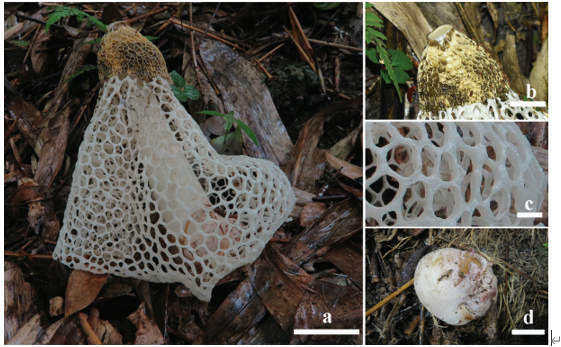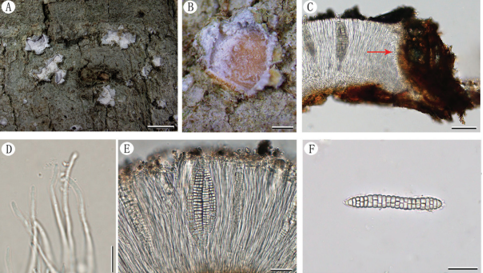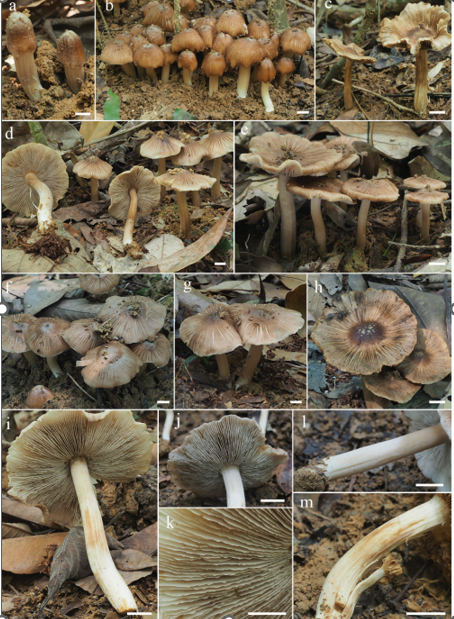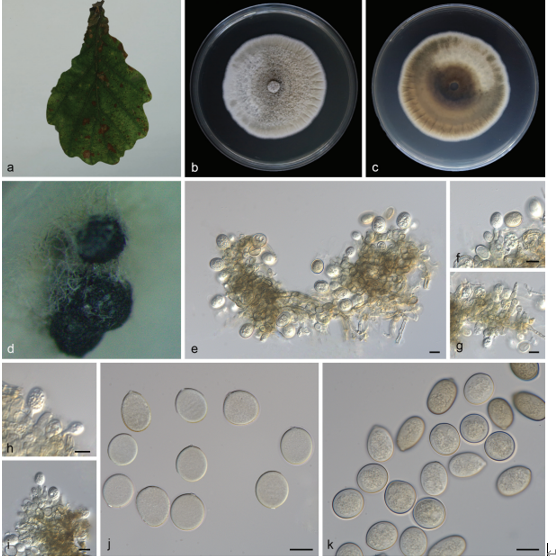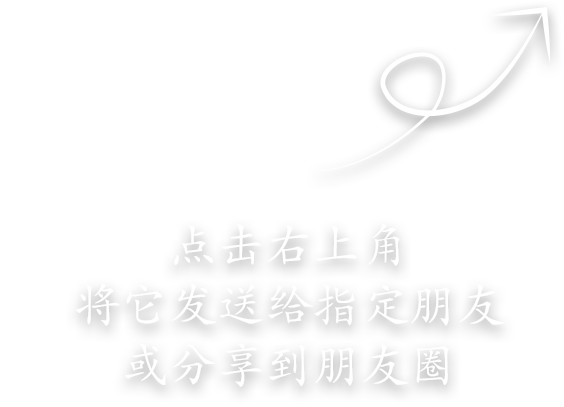Epipogium taiwanense T.C. Hsu 2020
MycoBank
Holotype: CHINA: Taiwan Province, Hsunchu City, Jianshih Village, 18 September 2012, S. K. Yu s.n. (holotype: TAIF).
Morphological description
The newly recorded species resembles Epipogium aphyllum in having coralloid rhizome, but differs from latter in its large size flower bract (2.0 × 1.0 cm, significantly longer than pedicel and ovary), epichile of labellum concave with 1 longitudinal ridge on mid-lobe and the spur strongly recurve in the apex connecting with bottom of mid-lobe.
Mycotrophic herbs, 10–22 cm tall. Rhizome coralloid, 1.0–1.3 × 0.5–0.6 cm, branching. Stem erect, terete, fleshy, pale brown, with a few membranous sheaths; sheaths amplxicaule, pale brown, 7–10 mm, membranous. Rachis laxly 3–4-flowered; flora bracts ovate, 2.0–2.4 × 1.0–1.2 cm. Flowers not resupinate, usually pendulous, weakly spreading, white, tinged with pink; pedicel 3.5–4.0 mm, ovary 7.2–7.5 mm. Sepals similar, lanceolate, 13–14 × 1.5–2.0 mm, apex acute. Petals oblong-lanceolate, 12–14 × 3.8–4.0 mm, apex acute. Labellum cordate when flattened, with purple spots, 13–14 × 18–20 mm. 3-lobed; lateral lobes erect, ovate-triangular, 7.2–7.5 × 3.5–3.8 mm, margins nearly erose; mid-lobed un-reflexed, ovate-elliptic, concave, 7.5–8.0 × 6.5–6.8 mm, margins erose, apex gradually acuminate; disk with 1 longitudinal ridge, white with purple spots; spur large, 1.1–1.3 cm in length, apex bilobed and strongly recurve. Pollinia 2, loosely granular-farinaceous, each with a slender caudicle; anther ovoid-ellipsoid; rostellum broad, 1.2 mm in width; column stout, 3.8–4.0 mm in length.
Habitat: in subtropical monsoon evergreen broad-leaved forest mixed with bamboo forest from 1770–2046 m in elevation
Distribution: from Hsunchu City, Taiwan province, Wumengshan National Natural Reserve (Luohanba village), Daguan County, Yunnan Province and Mabian-Dafengding National Natural Reserve, Mabian County, Sichuan Province, China.
GenBank Accession:
Notes: The character of coralloid rhizome indicates that the newly recorded species is significantly differed from other taxa of Epipogium, except E. aphyllum Swartz (1814: 32). Meanwhile, the shape and length of spur were variable among different populations. For example, the spur was slender and strongly curved in populations of Taiwan and Sichuan provinces, but was slightly stout and curved to connecting with bottom of mid-lobe at the apex in population of Yunnan Province. However, it is distinguished from latter by having white color flower with purple spots, large size of flower bract (20–24 × 10–12 mm, significantly longer than pedicel and ovary), disk with 1 longitudinal ridge on mid-lobe and the spur strongly recurve or connecting with bottom of mid-lobe at the apex (vs. yellow flower with pink or pale purple blotches, flower bract size is 6–9 × 2.8–4 mm and as long as pedicel and ovary, disk with 4–6 longitudinal ridges on the mid-lobe and spur erect or slightly recurve at apex in E. aphyllum) (Chen et al. 2009) (Table 1).
Reference: XUN-FENG WU1,4, QIANG LIU1,5*, YING TANG2,6 et al.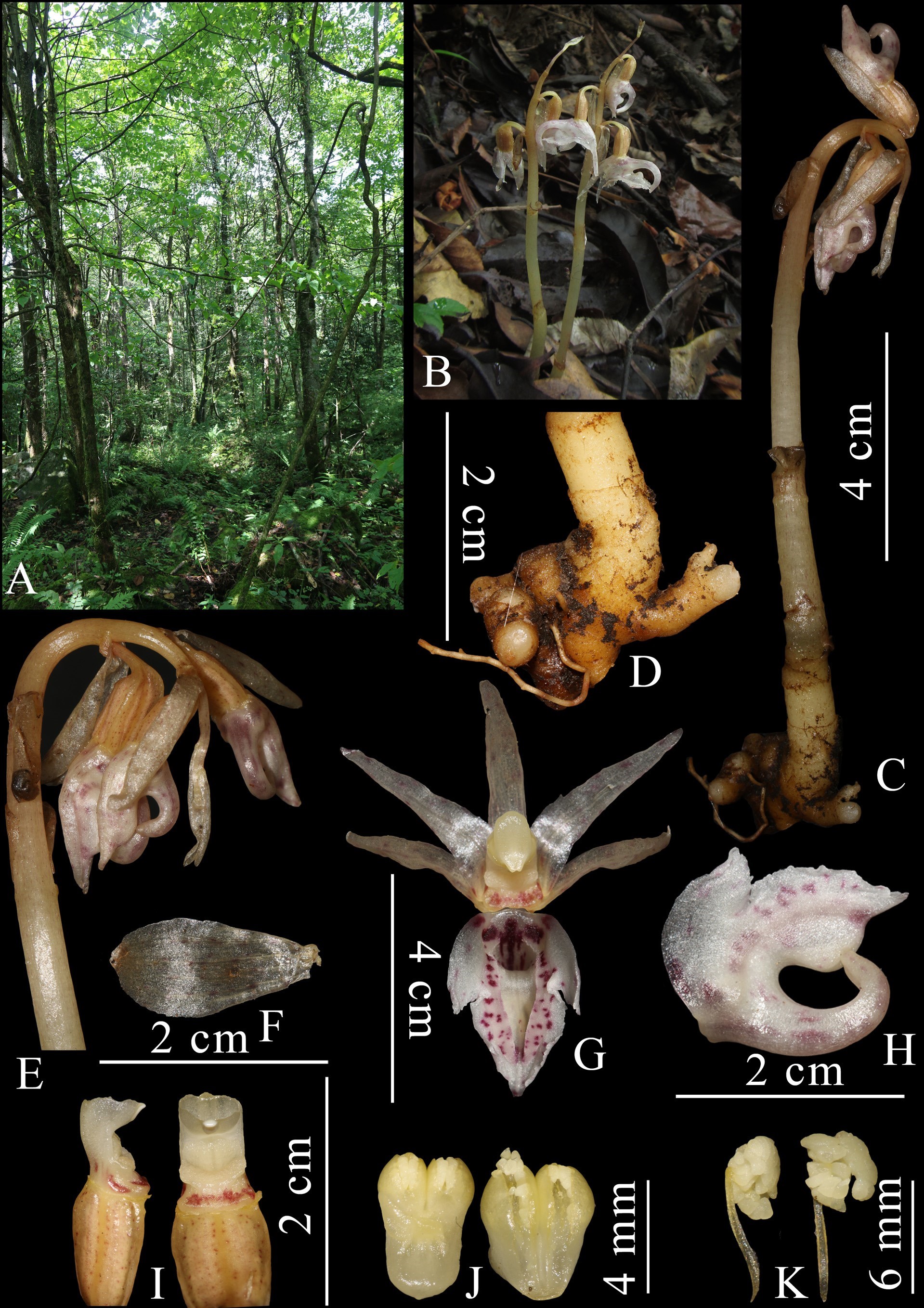
Epipogium taiwanense. A. Habitat. B (Photographed by Y. Tang) & C. Plant. D. Rhizome. E. Inflorescence. F. Floral bract. G. Flower. H. Lateral view of labellum with spur. I. Lateral and front view of column. J. Anther cap. K. Pollinarium (Photographed by Q.
Liu).


